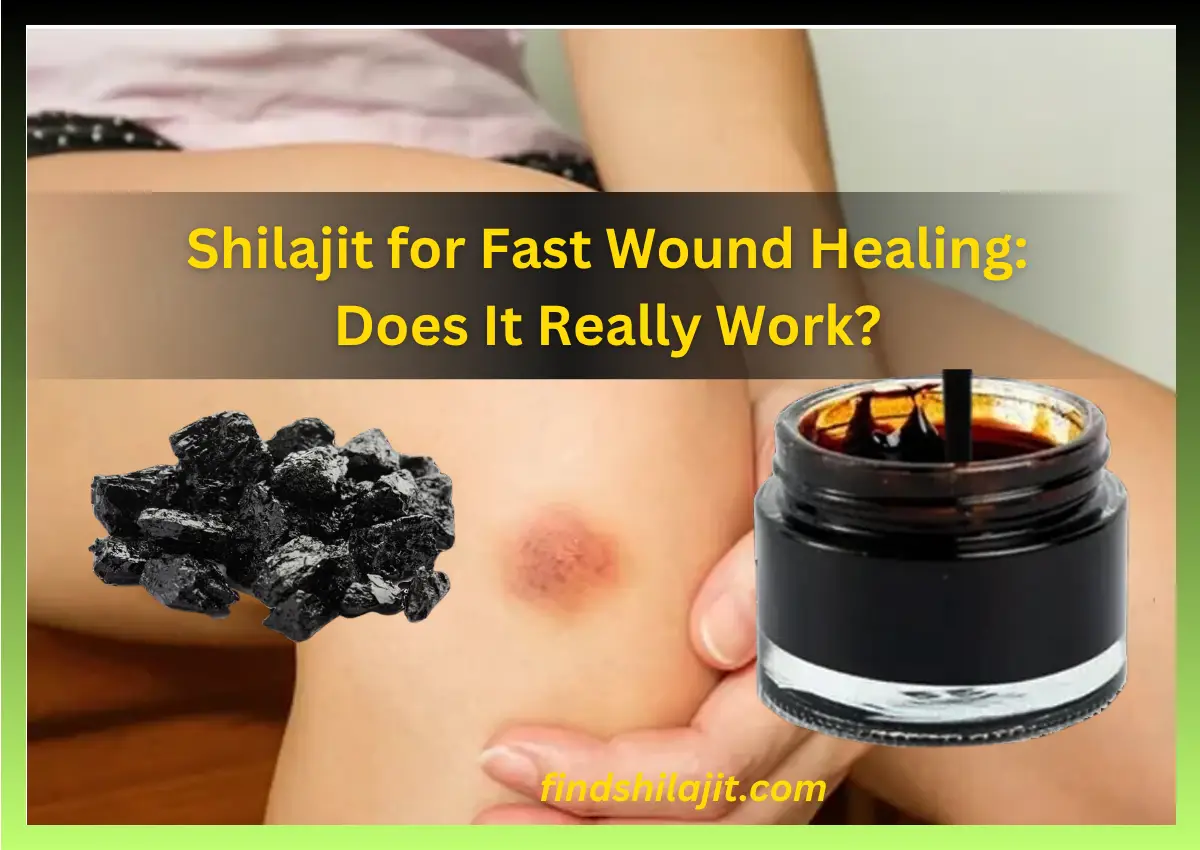I’ve been getting a lot of messages lately about Shilajit brands for fast healing of wounds, and I completely get why. When you’re dealing with cuts or burns, you naturally want something that can help your body repair itself naturally and safely.
Did You Know?
Shilajit is only found in high-altitude mountains (above 10,000 ft) — below that, the resin doesn’t form properly.
Over the last few years, Shilajit has been getting a lot of attention not just in Ayurvedic circles but also among people looking for natural ways to support their healing without any side effects on the body.
Shilajit is a resin that drips from the Himalayan and Altai mountain rocks.
It’s been used in traditional medicine for centuries, valued for its rich mineral profile (over 80 trace elements), fulvic acid content, and ability to support cellular energy production.
Shilajit can help reduce inflammation, boost tissue regeneration, and promote overall recovery.
In this guide, I’ll walk you through the science of Shilajit for wound healing, what makes certain brands stand out, and how to pick a product that genuinely supports your recovery.
Let’s Understand Wound Healing First
Before diving into which shilajit for fast healing of wounds is worth considering, it helps to understand what’s happening when your body heals.
Wound recovery isn’t a single event—it’s a multi-stage biological process that requires energy, nutrients, proper cellular communication, and much more. It stages like below:
- Inflammatory Phase: Right after injury, white blood cells clean the wound and fight infection, causing swelling and redness in your body.
- Proliferative Phase: The body produces collagen to rebuild skin and tissue, while new blood vessels form to deliver oxygen and nutrients.
- Remodeling (Maturation) Phase: New tissue strengthens, becomes more elastic, and blends with the surrounding skin over time.
For smooth healing, your body needs minerals like zinc, copper, and magnesium, along with strong cellular energy. Deficiencies from stress, poor diet, or chronic illness can slow recovery.
That’s why mineral-rich supplements like Shilajit, which are known to support energy production, are gaining attention for aiding wound healing. Once you understand how the body heals, using Shilajit to support the process starts to make real sense.
I find that once you understand these mechanisms, the appeal of using something like Shilajit to “nudge” your healing along makes a lot more sense.
What Makes Shilajit Special for Wound Repair?
Unlike synthetic supplements that focus on one or two compounds, Shilajit is a resin made over centuries by the decomposition of plants and minerals trapped in mountain rock.
- Fulvic Acid: A powerful antioxidant and anti-inflammatory compound that protects wound-site cells from oxidative stress and reduces swelling that can delay healing.
- Rich Mineral Content: Contains 80+ trace minerals—like zinc, copper, magnesium, and iron—that help build new tissue, collagen, and blood vessels.
- Cellular Energy Support: Boosts mitochondrial function, giving your cells the energy needed to repair and regenerate tissue more efficiently.
I still remember the first time I read about these properties—I thought it sounded too good to be true.
But once I understood that wound healing is your body’s repair work, fueled by nutrients and energy, the role of Shilajit suddenly made sense.
It’s not a magic shortcut but rather a natural source of the building blocks and energy your body already uses to heal.
Choosing the Best Shilajit Brands for Wound Healing
Not all Shilajit is created equal. Many of them are impure and adulterated. If you’re using it to support healing, quality matters more than ever. Here’s what to look for:
- Purity: Always check for third-party lab tests and certificates of analysis to ensure it’s free from heavy metals and contaminants.
- Source: Look for resin sourced from high-altitude regions like the Himalayas or the Altai mountain range
- Extraction Method: Low-temperature or patented extractions preserve delicate compounds like fulvic acid. Avoid high-heat processed versions.
- Fulvic Acid Content: Higher is better. Aim for products with at least 50% fulvic acid, clearly listed.
- Form: Pure resin is considered the most effective. Capsules and powders are convenient but may lose potency during processing.
In my own experience, the brands that take the time to show transparency about sourcing and testing tend to be the ones you can trust.
I always tell friends: if a company can’t prove what’s in their product, it’s better to skip it, especially when your goal is something as sensitive as supporting wound healing.
Pürblack and Other Top Shilajit Brands
Pürblack stands out for its patented low-heat extraction (5th/6th gen resin), which helps preserve fulvic acid.
It’s rich in healing minerals like zinc, copper, and magnesium, and it claims better absorption through a special coating.
Other strong contenders include Lotus Blooming Herbs and Sunfood, known for ethical sourcing and solid lab testing. Pürblack is premium-priced, but not your only high-quality option.
How to Use Shilajit Safely for Healing
Even the best Shilajit won’t help if used incorrectly. Here’s how to do it right:
- Dosage: Take 0.25–0.5 grams daily (pea-sized), dissolved in warm water, tea, or milk for better absorption.
- Frequency: Use once or twice a day. Effects build over time—be patient.
- Supportive Habits: Clean the wound, eat well, and rest—Shilajit works best alongside healthy recovery habits.
- Watch for Reactions: Stop use and consult a doctor if you notice irritation or discomfort.
Shilajit: Side Effects & Safety Tips
- Contamination Risk: Low-quality Shilajit may contain heavy metals or toxins. Don’t buy it.
- Allergic Reactions: Can cause mild rashes, itching, or stomach upset in some people. Stop use if symptoms appear.
- Drug Interactions: May affect blood pressure or blood sugar—consult your doctor if you’re on medication.
- Not a Substitute: Shilajit supports healing but doesn’t replace proper medical care for serious wounds or infections.
- Avoid in Pregnancy: Not enough safety data—avoid use unless approved by a healthcare provider.
Final Thoughts
Shilajit for fast healing of wounds isn’t a miracle cure or quick fix, but it can be a powerful ally in your body’s natural recovery process.
Its fulvic acid, minerals, and energy-boosting properties give your cells what they need to repair tissue and close wounds faster. But results depend on quality—low-grade or contaminated Shilajit may do more harm than good.
The biggest shift for me came when I stopped treating Shilajit as a quick fix and started using it as part of a bigger healing plan. If you’re looking for steady, natural support, the right Shilajit might be exactly what your recovery needs.
Frequently Asked Questions (FAQs)
Which minerals in Shilajit support tissue repair?
Zinc aids cell repair, copper forms new blood vessels, and magnesium supports metabolism—all essential for wound recovery.
How do I choose a good Shilajit brand for healing?
Pick brands with third-party lab tests, high-altitude sourcing, and low-heat extraction. Resin form with 50%+ fulvic acid is best.
Can I apply Shilajit directly to wounds?
Oral use is safer. For topical use, consult a doctor—most products aren’t tested for skin.
What’s the recommended dosage?
Take 0.25–0.5 grams daily in warm water or tea. Be consistent for a few weeks.
Are there any side effects?
Possible risks: poor-quality products, allergies, or drug interactions. Use trusted brands and check with your doctor if unsure.
How long until I see results?
Usually, within a few weeks of regular use, depending on the wound and overall care.
Is Shilajit safe for everyone?
Generally safe for healthy adults. Avoid during pregnancy, for kids, or if you have certain conditions—unless approved by a doctor.
References:
Disclaimer
This article is for informational purposes only. Please consult a licensed healthcare provider before starting any new supplement, especially if you are pregnant, breastfeeding, or on medication.



